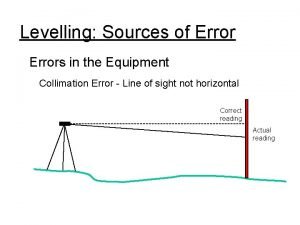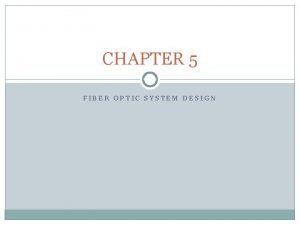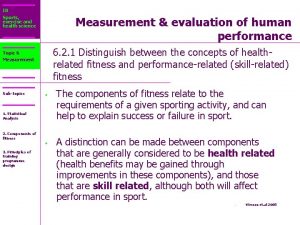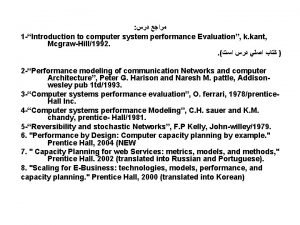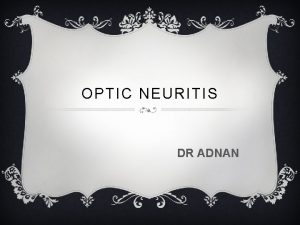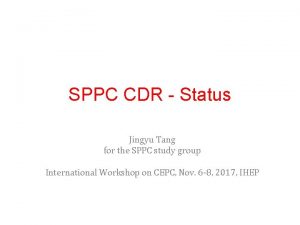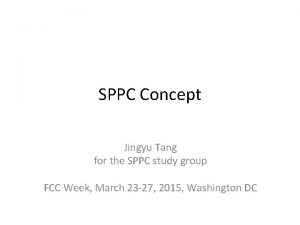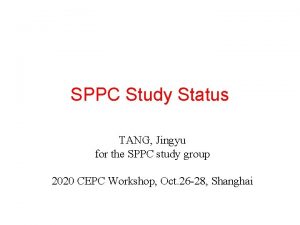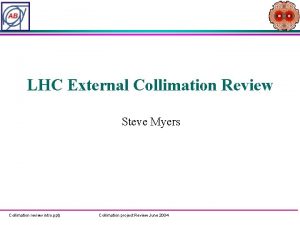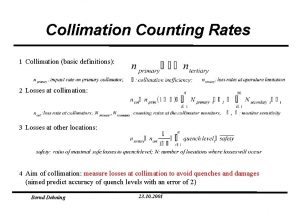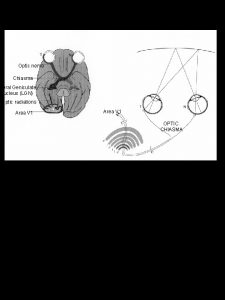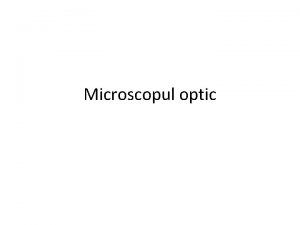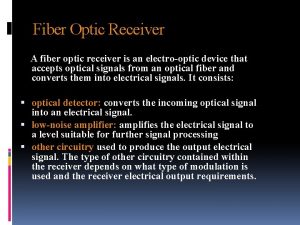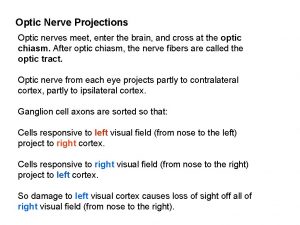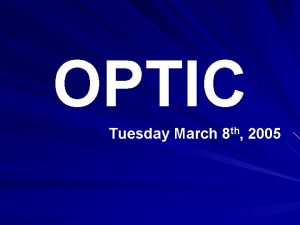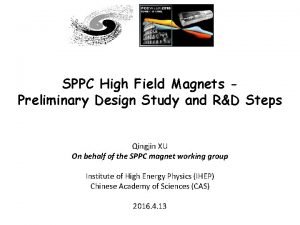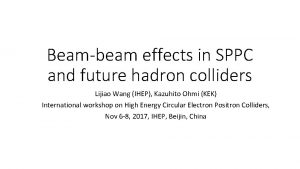Optic design and performance evaluation for SPPC collimation



























- Slides: 27

Optic design and performance evaluation for SPPC collimation systems 11 th FCPPL workshop May 24 th, 2018 Jianquan Yang, Ye Zou, Jingyu Tang Institute of High Energy Physics, CAS, Beijing

Outline • Introduction • Goals and motivations • Optics design • Multi-particle simulation results • Protection scheme of the SC magnets • Conclusions • Next to do

Introduction • Baseline design • Tunnel circumference: 100 km • Dipole magnet field: 12 T, using full iron-based HTS technology • Center of Mass energy: 75 Te. V • Injection energy: 2. 1 Te. V • Relatively lower luminosity for the first phase, higher for the second phase • Energy upgrading phase • Dipole magnet field: 20 -24 T, full ironbased HTS technology • Center of Mass energy: >125 Te. V • Injector chain: 4. 2 Te. V Main parameters of SPPC Parameter Unit Value Proton energy Te. V 37. 5 Nominal luminosity cm-2 s-1 1. 01× 1035 Number of IPs - 2 Bunch separation ns 25 Bunch filling factor - 0. 756 Number of bunches - 10080 Bunch population × 1011 1. 5 Normalized rms transverse emittance rms bunch length μm 2. 4 mm 75. 5 Stored beam energy per beam GJ 9. 1

Introduction Layout of SPPC from Y. K. Chen • Use the same tunnel to build CEPC and SPPC successively • 8 ARCs, total length 83900 m (including DS) • 2 long straight insertion for collimation and extraction (ee for CEPC), 4300 m each • Dipole length needed: 65. 45 km • Filling factor: 0. 79 • ARC length: 65. 45 km/0. 79=82. 9 km, Considering some reserved length, ARC length is chosen as 83. 9 km, left 16. 1 Km for long straight section

Introduction • Length 4300 m • Arrange the transverse and momentum collimation in the same long straight insertion • Four groups of SC dipoles are used to produce required dispersion for momentum collimation cancel the dispersion at the section end • Compatibility of two sets of collimation system for each beam needs to be considered • Why choosing this layout will be explained later Layout of collimation insertion

Goals Collimation efficiency Main functionality • Quench prevention: for SPPC: • Halo particles cleaning • Machine protection: prevent damaging radiation-sensitive devices • Radiation losses concentration: hands-on maintenance • Cleaning physics debris: collision products • Optimizing background: in the experiments • halo diagnostics

motivations Multi-stage collimation in LHC • 98 two-sided and 2 one-sided movable collimators; 396 degrees of freedom • Two warm interaction regions are used to provide betatron and momentum collimation • Primary collimators scatter the primary halo • Secondary collimators intercept and stop part of the scattered particles • Absorbers stop the showers • Tertiary collimators protect the SC dipoles or Quadrupole triplets in IP • TCLs absorb physics debris From S. Redaelli

Motivations challenges • Particle losses in the DS are the highest cold losses around the ring, may pose a certain risk for inducing magnet quenches • Single Diffractive scattering drives the secondary hole to dispersion suppressor: Such protons can emerge from the collimator jaw with their momentum modified only slightly in direction, but significantly in magnitude. From B. Salvachua

motivations The novel collimation method From M. Fiascaris • Single diffractive scattering Loss from 7 Te. V to 37. 5 Te. V factor 7 • The particles experiencing single diffractive interactions in the primary collimators will loss in the cold magnets of DS • In order to deal with these particle losses, we can arrange the transverse and momentum collimation in the same cleaning insertion

Optics design Requirements I

Optics design • Novel collimation method • Need some dipole magnets to produce the required dispersion for the momentum collimation and cancel the dispersion at the end • Betatron collimation requires significantly longer space for multi-stage collimation and the two proton beams • Compatibility with two sets of collimation system for each beam Requirements II

Optics design • Symmetric dispersion suppressor • 4 groups of superconducting dipoles, each group consists 5 dipoles, length 14 m, gap 1 m, same as in ARC • 9 quadrupoles are installed, the strength of pole is no more than 8 T • The primary momentum collimator is placed between the second and third groups of dipoles with almost maximum negative dispersion Momentum collimation

Optics design Lattice scheme I • warm quadrupoles are used in the transverse collimation because of their strong anti-radiation ability Beta Coll. Delta Coll. 1. 86 π 2. 24 π 1. 88 π 2. 11 π 1810 m 1055 m 1903 m 1010 m

Optics design Lattice scheme II • apply superconducting quadrupoles in the transverse collimation section • These quadrupoles are different from those in ARC, they will be designed with enlarged aperture and lower pole strength (no higher than 8 T) • enhanced phase advance • Addition of the tertiary collimators in enhanced phase advance, following the secondary collimators, in order to clean the tertiary halo Beta Coll. Delta Coll. 3. 54 π 2. 27 π 3. 31 π 2. 14 π 1600 m 905 m 1470 m 885 m

Optics design Lattice scheme II • Compatibility with two sets of collimation system for each beam • Quadrupoles with twin apertures are installed in the overlapping region between the two beam • Quadrupoles with single aperture are installed in the position with horizontal offset

Simulation results Lattice scheme I Vertical halo distribution Lattice scheme II Ø the four-stage collimation system can make the local cleaning inefficiency in the cold region below the quench limit of SC magnets.

Simulation results Lattice scheme I Horizontal halo distribution Lattice scheme II Ø For initial horizontal halo distribution, the spike proton losses can be reduced to half by introducing 11 tertiary collimators, but local protective collimators are still needed to dispose the proton losses related the single diffractive effect.

Simulation results Vertical halo Comparation of two lattice schemes Horizontal halo

Simulation results Local protection • Installation of some protective collimators at the places where dispersion increases gradually: the particles with large momentum dispersion will impinge on the front momentum collimators firstly, and the particles with small momentum dispersion will impinge on the follow-up collimators. Ø There is no proton losses in the cold region exceed the quench limit along the full ring. All simulations are carried out only with collision insertion and only considering the linear condition

Protection scheme Quench limits ØThe quench level is defined as the minimum local energy or power deposition that, for a given beam-loss scenario, will result in a transition from superconducting to normal conducting state. ØFactors: • • • local magnetic field operating temperature cooling conditions geometrical loss pattern time distribution of beam losses Ø Short-duration (t < 50 μs) Ø Intermediate duration (50 μs ≲ t ≲ 5 s) Ø Steady state (t > 5 s)

Protection scheme Ø SC quadrupoles in HL-LHC Ø In betatron collimation section, the highest quadrupole field is 8 T, which is lower than the IR quadrupole in LHC. Ø Considering the He II and He boiling heat transfer mechanisms, which allow extracting more heat from the cable than the only solid conduction through the cable insulation, the quench limit value is estimated as 50~100 m. W/cm 3. Quench limits From P. P. Granieri

Protection scheme FLUKA simulation Ø Which quadrupole will bear the greatest risk of quench? Geometry model: Aperture: 80 mm Length: 6 m

Protection scheme Energy deposition in SC quadrupole Ø Shielding: placed in front of the QD for one meter, which is a hollow cylinder, with length 3 m and inner half-aperture 10 mm, about 37 σ. Ø Assume that 30% of all stored SPPC protons will be lost in the collimation section in one hour Step-like aperture: the aperture of the rear half is enlarged to 10. 2 mm

Protection scheme Energy deposition in SC dipole Ø Quest limit estimation: 5~10 m. W/cm 3 Ø one protective collimator is placed between the third and fourth dipole magnets of the first dipole group to intercept particles with very large momentum deviation. Aperture: 50 mm Length: 14. 5 m

conclusions • The combined collimation method by arranging both transverse and momentum collimation systems in the same cleaning insertion and employs superconducting quadrupoles has a good performace. The goal of collimation inefficiency 7 10 -7 m-1 can be accomplished. • With protective shieldings, the power deposition in the superconducting coils in the collimation section can be reduced to below 10 m. W/cm 3, which is safe by a large factor from quenching.

Next to do • Study the background sources from beam-beam interactions and the collimator themselves. • Consider the effect of the layout on the machine impedance, beam energy deposition studies and power loads, as well as other safety and sustainability issues.

Thank you for your attention
 And a modular collimation system
And a modular collimation system Sextant working principle
Sextant working principle Error of collimation
Error of collimation Collimation star test
Collimation star test Progress and performance measurement and evaluation
Progress and performance measurement and evaluation Evaluation in progress
Evaluation in progress Fiber optic system design
Fiber optic system design Measurement and evaluation in human performance 5e download
Measurement and evaluation in human performance 5e download Vertical jump adalah
Vertical jump adalah Computer architecture performance evaluation methods
Computer architecture performance evaluation methods Portfolio performance evaluation problems
Portfolio performance evaluation problems Behaviorally anchored rating scale
Behaviorally anchored rating scale Are criteria for evaluating performance of channel members.
Are criteria for evaluating performance of channel members. Computer systems performance analysis
Computer systems performance analysis Mco pes
Mco pes Direct support professional performance evaluation
Direct support professional performance evaluation Performance evaluation for decentralized operations
Performance evaluation for decentralized operations Purchasing performance evaluation
Purchasing performance evaluation Citibank performance evaluation case study
Citibank performance evaluation case study Housekeeping performance improvement plan
Housekeeping performance improvement plan Principles of performance appraisal
Principles of performance appraisal Stronge leader effectiveness performance evaluation model
Stronge leader effectiveness performance evaluation model Performance evaluation using variances from standard costs
Performance evaluation using variances from standard costs Library staff performance evaluation
Library staff performance evaluation Channel performance evaluation
Channel performance evaluation Performance evaluation model
Performance evaluation model Da form 7223
Da form 7223 Pep performance evaluation
Pep performance evaluation


